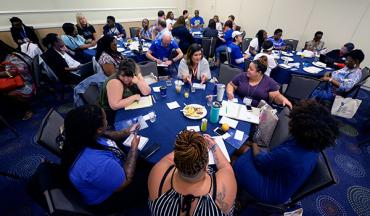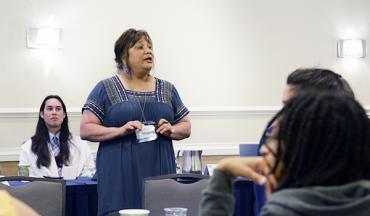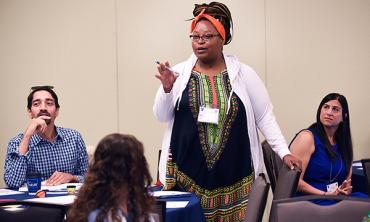To teach and to reach all students, schools must find ways to be inclusive by ensuring that all students are valued and their educational and personal needs are met. Many sessions at AFT TEACH focused on inclusion through the lens of equity and social justice.
For the first time at a TEACH conference, educators addressed how Native Americans are represented in the classroom and how to break traditional destructive stereotypes.
“How is it that American Indians can be so present and so absent in our everyday lives?” asked Giselle Lundy-Ponce, executive assistant to the AFT executive vice president of the AFT, who moderated the session. She noted that there are 600 trademarks that show Native Americans as caricatures. These are common misrepresentations that include the mascot for the Atlanta Braves baseball team and the Native American woman on the label for Land O’ Lakes butter. “These are not real portraits,” Lundy-Ponce says. “You don’t have Native Americans saying thank-you for this butter.”
Leander Houston, a Native American who teaches high school biology in Orlando, Fla., told session participants that Native American culture needs to be embraced in the classroom. He says that his Native American students “see their cultural background or history as negative, but that’s not true. Their culture is what will give them strength.”\
Houston explained that teachers need to find Native Americans represented in science, art and literature, so that these students can imagine themselves in all kinds of careers.
But Kristine Montgomery, a Native American who teaches high school social studies in Bismarck, N.D., says schools have a long way to go because teachers and administrators still pigeonhole Native American students. “People will say, ‘Oh, they’re such good artists, let’s get them in as many art classes as possible.’ ”
Montgomery says it is paramount in her high school classes to respect all students.
If Native American students don’t have a sense of community, “they feel isolated and shut down,” she says. “Every group deserves respect.”
Another session, “Beyond Bias and Backlash: Elevating Girls of Color in Addressing the #MeToo Movement and the School-to-Prison Pipeline,” provided educators with resources to promote a safe, healthy and inclusive environment for all students with a focus on the needs of girls of color.
In schools nationwide, black, Latina and American Indian/Alaskan Native girls are being unfairly pushed out with suspensions and expulsions. “On average nationally, black girls are six times more likely to be suspended for minor infractions like going against strict dress codes or talking back,” said Adaku Onyeka-Crawford, senior counsel for education at the National Women's Law Center. Such practices tell these girls that school is not a welcoming place. “Educators must acknowledge the biases by recognizing them and calling them out,” she said. “You have to talk about race and biases to address this problem.”
When it comes to school discipline, educators should be aware if their school is enforcing rules more harshly based on race or sex—like imposing harsher dress code rules for girls than boys or banning hair styles such as cornrows, dreads and braids, which would harm black girls disproportionately,” said Onyeka-Crawford. “Identifying red flags like that can counter pushout in the classroom.”
There are solutions that can put an end to school pushout of girls of color. “Providing a safe space for students is important,” she said. “As educators, you are advocates, and you can push for change. Students have the right to bring their authentic selves to school.”
The NWLC’s Let Her Learn campaign provides tools that educators and advocates can use to create change.
[Adrienne Coles/Mike Campbell photos]



